|
|
|
|
Geometry and use
of trigonometry
|
|
|
|
Quadrilaterals
|
|
A
quadrilateral is a plane figure formed by
four sides. Common quadrilaterals are,
square, rhombus, rectangle, parallelogram,
kite (or deltoid) and a trapezium (or a
trapezoid). Quadrilaterals are usually
classified as cyclic quadrilaterals and
tangential quadrilaterals. |
| Meaning
of symbols used in pictures and in
formulas are, |
| d
- diagonal, h
- altitude, m
-median, t
- angle bisector,
r
-radius
of the incircle, R
- radius of the
circumcircle, A
- area, P
- perimeter,
s
- semi-perimeter, S
-
sum. |
|
|
Square
|
| A
square is a plane figure with four sides of equal length and
four right angles. The
two diagonals, which are of equal length, bisect each other
perpendicularly. The
square has four axes of symmetry. |
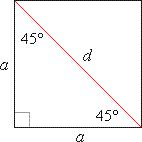 |
 |
| perimeter,
P
= 4a |
| area,
A
= a ·
a = a2,
A
= a2 |
|
|
|
|
Rhombus
or rhomb
|
| A
rhombus is an oblique-angled parallelogram whose four sides are equal.
Rhombus
diagonals bisect each other perpendicularly. The
rhombus is symmetrical about both of its diagonals. |
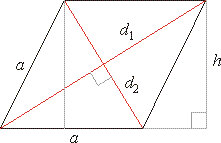 |
 |
| perimeter,
P
= 4a |
| area,
A
= a ·
h and |
 |
|
|
|
|
|
Rectangle
|
| A
rectangle is a plane figure with four straight sides, two parallel pairs
of equal length forming four right angles. The two diagonals of
a rectangle have equal lengths. The
rectangle has two axes of symmetry. |
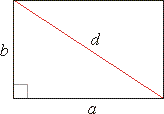 |
| diagonal, |
 |
|
| perimeter,
P
= 2(a + b) |
| area,
A
= a ·
b |
|
|
|
|
Parallelogram
|
| A
parallelogram
is a quadrilateral (plane figure with four sides) with opposite
sides parallel and of equal length. The
opposite angles of a parallelogram are also equal. In
the case in which the angles are all right angles the
parallelogram is a rectangle, and when all the sides are equal
it is a rhombus. |
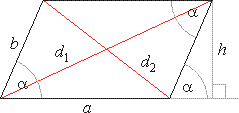 |
|
|
| perimeter,
P
= 2(a + b) |
| area,
A
= a ·
h |
|
|
|
|
Kite
or deltoid
|
|
A
kite or deltoid is a quadrilateral with two pairs of equal
adjacent sides.
|
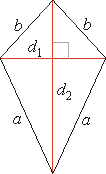 |
|
Two
of the angles in a kite are opposite and equal.
|
| The kite's diagonals cross perpendicularly, and one of them (the shorter one) is being bisected by the other.
|
| perimeter,
P
= 2(a + b) |
| area, |
 |
|
|
|
|
|
Trapezium
or trapezoid
|
| A
trapezium or trapezoid is a quadrilateral with two parallel
sides of unequal length. The trapezium's median is a straight line joining the midpoints of
nonparallel sides and parallel to the two parallel sides. |
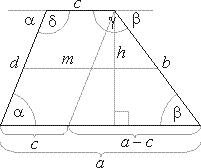 |
| a
+ d = 180°, b + g = 180° =>
a + b + g + d =
360° |
| median,
m = 1/2(a +
c),
area,
A
= m ·
h |
| perimeter,
P
= a + b + c + d |
| area,
A
= c·h + 1/2(a -
c)·h,
A
=1/2(a
+ c)·h |
|
|
|
|
Isosceles
trapezoid
|
| A trapezoid with the two nonparallel sides of equal length and the angles opposite those sides equal, is called an isosceles trapezoid. |
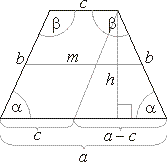 |
| a
+ b = 180°, |
| median,
m = 1/2(a + c),
area,
A
= m ·
h |
| perimeter,
P
= a + 2b
+ c |
| area,
A
= c·h + 1/2(a -
c)·h,
A
=1/2(a
+ c)·h |
|
|
|
|
Cyclic quadrilateral
|
| A
quadrilateral inscribed in a circle, so that all its vertices
lie on the circumference is called a cyclic
quadrilateral. |
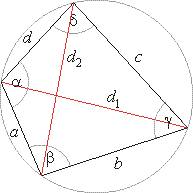 |
| The
opposite angles of a cyclic quadrilateral are supplementary. |
| a
+ g = b + d = 180°, |
| d1
· d2
= a · c + b
· d |
| perimeter,
P
= a + b
+ c
+ d, s
= ( 1/2)P |
| area, |
 |
|
|
|
|
|
Tangential quadrilateral
|
| A
quadrilateral whose sides all lie tangent to the circle
inscribed within the quadrilateral is called a tangential
quadrilateral. |
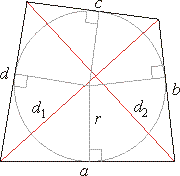 |
| s
= a +
c = b + d, |
| perimeter
P
= a + b
+ c
+ d, s
= 1/2P |
 |
|
area,
A
= r · s
|
|
|
|
|
Polygons
|
| A
polygon is closed plane figure
bounded by a number of straight line segments with the same
number of vertices. The
sum of interior angles is (n
-
2) · 180°, where n
is the number of sides of a polygon. The
sum of exterior angles of a polygon is 360°. |
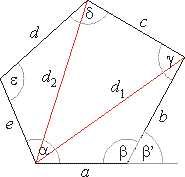 |
| dn
- number
of diagonals |
| b'
- the
exterior angle |
| dn
= 1/2 · n · (n
-
-
3) |
|
Sn=
(n
-
2)
· 180° - the
sum of interior angles
|
|
|
|
|
Regular
polygons
|
| In
a regular polygon all sides are equal and all its angles are
equal. The
exterior angle of a regular polygon is b'
= 360°/n, where n
is the number of sides of a regular polygon. |
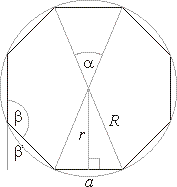 |
| a
=
b'
= 360°/n,
b'
- the
exterior angle
|
| b
=
180°
-
b'
= (n
-
2)
· 180°/n,
P = n · a |
| dn
= 1/2 · n · (n
-
-
3)
- number
of diagonals |
|
A
= 1/2 · n · a · r
= 1/2P · r
- area of a regular polygon
|
|
|
|
|
|
|
|
|
|
|
|
|
|
|
|
|
|
|
|
|
|
|
|
|
|
|
|
|
|
|
Contents
D
|
|
|
|
|

|
|
|
|
|
|
Copyright
© 2004 - 2020, Nabla Ltd. All rights reserved.
|
|
|